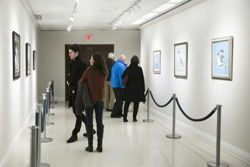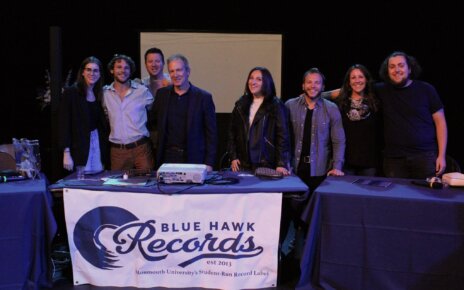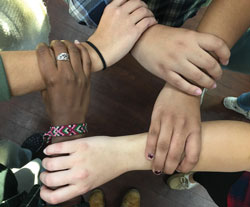 Rare Wildlife Revealed: The James Fiorentino Traveling Art Exhibition, an exhibition spotlighting endangered species native to New Jersey, was honored by a reception held in partnership with the Conserve Wildlife Foundation of New Jersey (CWF) this past Friday, Feb. 9 in Pollak Gallery.
Rare Wildlife Revealed: The James Fiorentino Traveling Art Exhibition, an exhibition spotlighting endangered species native to New Jersey, was honored by a reception held in partnership with the Conserve Wildlife Foundation of New Jersey (CWF) this past Friday, Feb. 9 in Pollak Gallery.
The event was an opportunity for the public to view this collection, meet artist Fiorentino, and donate to the CWF. All of the displayed paintings are for sale, with a portion of proceeds being donated in support of the CWF and its mission, according to David Wheeler the Executive Director of the Conserve Wildlife Foundation.
The mission of the CWF is to aid biologists in protecting, understanding, and preserving the habitats and existence of these threatened species, according to Martin McHugh, former CWF Board Chairman and current Board member.
The Wildlife exhibition displays the art work of Fiorentino, capturing the “magnificent and minute details of endangered and threatened wildlife local to New Jersey,” said Wheeler.
This event offered an educational experience to the viewer as well an opportunity to connect with threatened animals and other wildlife. Amanda Green, a senior student of fine arts and the President of Artists for Change, said, “I didn’t know these animals were all native to New Jersey. Although, I did see a seal walk across the beach in Midway once. You never know what you’ll find here.”
“When I look at these pieces I feel a call to action. See, if there was just one animal here, like an eagle, it would not be very impactful, but seeing all of these different animals in a collection and knowing that they are all in danger and need our help to survive or their species will be gone forever, is very awakening, motivating, and meaningful,” Green continued.
“In our world, so separated from the natural environment, Fiorentino’s art reminds us of the wild beauty that we are rapidly losing and will continue to lose if we do not actively protect it,” said Kimberly Callas, an assistant professor of art and design and the founding artist of Discovering the Ecological Self, an art project designed to foster environmental stewardship.
According to Corey Dzenko, Ph.D., an assistant professor of art history, “Art can make a difference by raising new questions and offering creative solutions to ongoing problems. Whereas a politician might try to affect policy, and other activist scholars offer solutions by lecturing or writing, artists do similar work but toward the creation of art.”
“Artists draw their research from many forms and incorporate it into their creative projects. Then their creative projects may inspire a viewer to think differently about a given topic, including wildlife and ecology, and the dialogue and processes of social change continue.” According to Dzenko, “Art can make a difference by raising new questions and offering creative solutions to ongoing problems. Whereas a politician might try to affect policy, and other activist scholars offer solutions by lecturing or writing, artists do similar work but toward the creation of art.”
“Artists draw their research from many forms and incorporate it into their creative projects. Then their creative projects may inspire a viewer to think differently about a given topic, including wildlife and ecology, and the dialog and processes of social change continue.”
According to Fiorentino, love for and inspiration from wildlife has been a lifelong relationship between himself and animals in the state. As a member of the Society of Animal Artists and Artists for Conservation, also a trustee of the Raptor Trust of NJ and D & R Greenway Land Trust, Fiorentino found that many of the wildlife he has painted could be found even in his own backyard.
At age 15, Fiorentino’s portrait of Reggie Jackson became a permanent contribution to the National Baseball Hall of Fame. From that point he has painted intimate portraits of individuals embedded in sports culture like Muhammad Ali, congressman like Buzz Aldrin, and a large portfolio of other significant individuals in these fields and others before beginning Wildlife Artistry, said Fiorentino. Many of his portraits are settled into various ‘Hall of Fames,’ National and International Museums, and in libraries, like that of former U.S. President George Bush.
The Conserve Wildlife Foundation and Fiorentino began their relationship together when the CWF asked Fiorentino to judge their ‘Species of the Edge’ competition, which according to the CWF website, “empowers fifth grade students to advocate for an endangered or threatened species from New Jersey through a well-researched, creative essay and original art piece.”
In addition to housing the exhibition, Monmouth University has relations with CWF at an academic and experiential education level.
According to John Tiedemann, Assistant Dean of the School of Science and the Director of the Marine and Environmental Biology & Policy Program, the department has been working with CWF for almost 17 years.
“Conservation and preservation are necessary. We want to teach our students to work for the future,” said Tiedemann.
Monmouth student artists who were present at the exhibition found inspiration in the work and related this to the philosophies and methods taught by Callas.
“The fact that these paintings are water color draws me in as an artist. It makes me wonder how he does it, and it develops a connection to me, the piece, and the animals. When I leave here to teach kids, I want them to connect too,” said Green.
Jenn Defranza, a senior fine arts student of Callas and the Vice President of Artists for change, shared similar feelings to Green and said, “Growing up in Long Island has made me very in touch with the environment and makes me happy teach students about pollution and the melting polar ice.”
“We look at how humans create meaning from nature through art and nature-based symbols, as we learn more about our natural environment, through the project, MU students get to become environmental leaders as they partner with the youth to create nature-based art and other environmental projects,” said Callas.
John Morano, a professor of journalism, advisor to the Outlook, and author of the Morano eco-adventure book series, said, “You have a talent. What are you going to do with? He could be painting anything- sneakers, cars. He chooses to paint life. Imperiled life… even better.”
“If the art means nothing to you, it means nothing to the viewer,” said Green.
The Rare Wildlife Revealed exhibition will be in Pollak until February 19th, and then reappear at Drew University from May 21 to June 22. This art remains available to purchase with a portion of proceeds supporting CWF.
For details visit the CWF website or James Fiorentino Art online.
PHOTO COURTESY of Tina Colella Photography



